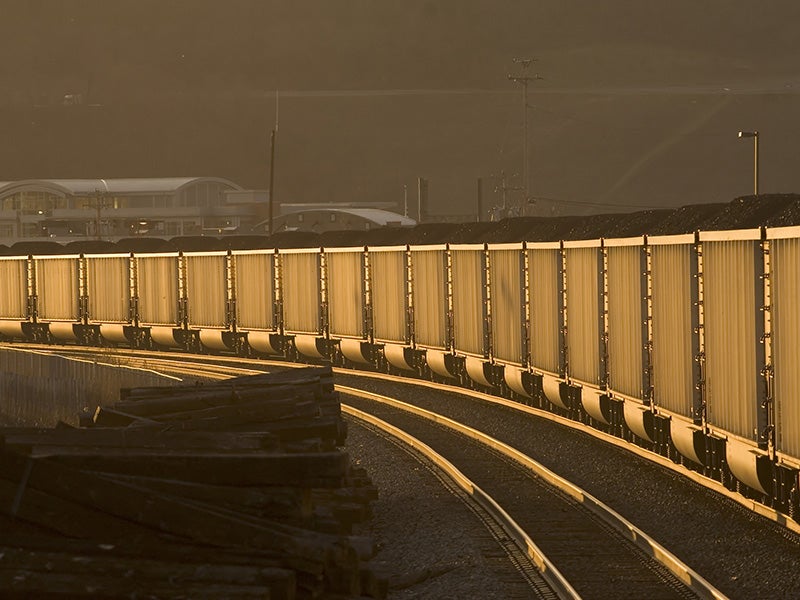Conflicts Over Coal Export in Pacific Northwest
With domestic demand for coal waning in the United States, coal companies seek to ship as much coal as possible from Montana and Wyoming’s Powder River Basin to emerging Asian economies. Earthjustice is calling for environmental review of proposed projects.

This page was published 13 years ago. Find the latest on Earthjustice’s work.
(Editor’s Note: This is the first in a series of blog posts by the author on issues related to proposed coal exporting from the Northwest.)
“When we try to pick out anything by itself, we find it hitched to everything else in the Universe.” —John Muir
We are often reminded—perhaps nowhere more profoundly than in nature—that life does not persist solely of its own volition. When we look closer, we invariably find that the whole is greater than the sum of its parts. In German, the phenomenon is called gestalt—the notion of the unified whole.
This is the proper lens through which to analyze the increasingly controversial issue of coal export in the Pacific Northwest. With domestic demand for coal waning in the United States, coal companies seek to ship as much coal as possible from Montana and Wyoming’s Powder River Basin to emerging Asian economies. Thus, there are six coal export terminal projects currently proposed for Pacific Northwest ports: Longview, Wash.; Bellingham, Wash.; Grays Harbor, Wash.; Coos Bay, Ore.; the Kinder Morgan terminal at Port of St. Helens, Ore.; and the Ambre Energy project with facilities at the Port of Morrow and the Port of St. Helens, Ore.
An environmental analysis examining each project in piecemeal fashion would not address the overall cumulative impacts to the region’s environmental health and quality of life. The cumulative impacts of the proposed coal export terminals would be significant:
- If operated at capacity, the terminals would more than double the amount of coal exported by the United States.
- About 60 to 65 daily trains, a mile-and-a-half long each, would run through towns and cities between the Powder River Basin and the Pacific Northwest. The volume of trains would cause traffic delays that would slow response times for paramedics, police, and firefighters.
- The trains transporting the coal would use open boxcars that spew coal dust into the air as they travel, risking the health of surrounding communities. Coal dust exposure can result in bronchitis and emphysema, and has been shown to cause tumor growth in animals.
- At export terminals, the coal would sit in enormous open-air piles allowing wind to blow coal dust into nearby towns, threatening the health of the citizens.
- Coal dust can settle into the soil, water, and plants, inhibiting photosynthesis.
- Federally protected endangered or threatened species may have their habitat negatively impacted by the coal terminal projects. Species that could be harmed include Chinook salmon and steelhead trout.
- Once the coal reaches Asia and is burned in coal-fired power plants, the resulting air emissions will contribute significantly to global warming pollution. Further, the air pollution from the power plants in Asia will eventually make its way to the West Coast of the United States, fouling skies and threatening public health.
Earthjustice attorney Jan Hasselman, who has been at the forefront of the coal export fight since day one, recently took a step back and saw the whole forest for the trees. As more and more coal export terminal plans were made public during the past year, it became clear that the Pacific Northwest is not dealing with a singular phenomenon or the crackpot vision of some fly-by-night developer. Instead, the region is being targeted by Big Coal to serve as the shipping arm of a coal resource colony. In the name of corporate profits, the goal is to feed Asian demand without regard for the environment and the communities of the Pacific Northwest.
On behalf of Climate Solutions, Sierra Club, Washington Environmental Council, Greenpeace, Columbia Riverkeeper, Coos Waterkeeper, Washington Conservation Voters, and RE Sources, Hasselman wrote the Army Corps of Engineers in April, asking the agency—which is responsible for permitting the coal export terminals—to conduct a programmatic environmental impact statement (EIS) on the cumulative impacts of the proposed projects. In other words, John Muir’s articulation of nature as a unified whole applies to the issue of coal export.
The Earthjustice letter generated support for the idea of a programmatic EIS from the Environmental Protection Agency (EPA), Oregon Gov. John Kitzhaber, sitting congressmen, numerous cities and counties (including both Seattle and Portland), and various state agencies.
Consideration of the cumulative environmental impact of a proposed project is a hallmark of environmental law. During the 1980s and 1990s, the analysis of cumulative impacts proved essential in the fight to preserve Northern California’s old-growth forests.
The issue of coal export in the Pacific Northwest is far from settled. The proposed projects hinge on myriad financial and logistical variables. But leaving economic vagaries aside, an environmental analysis of the projects’ inherent gestalt essence will reveal what is at stake for the region’s communities. The proposed coal export terminals are a full-scale assault on the environment and the Pacific Northwest—the public has the right to a holistic understanding of the consequences.
The proposed site for a coal export facility in Longview, on the shores of Washington’s Columbia River. (Paul Anderson)
Established in 1987, Earthjustice's Northwest Regional Office has been at the forefront of many of the most significant legal decisions safeguarding the Pacific Northwest’s imperiled species, ancient forests, and waterways.